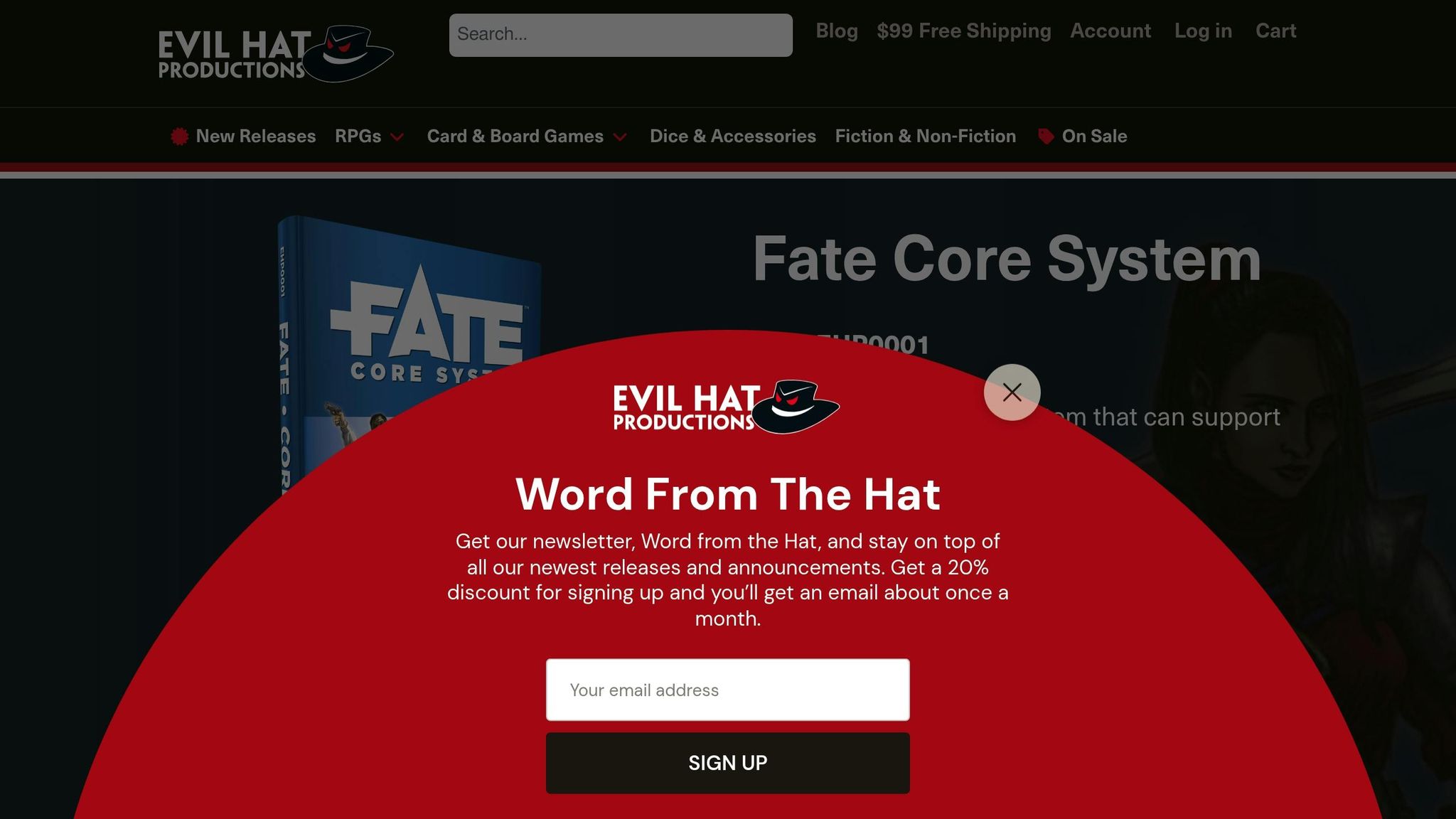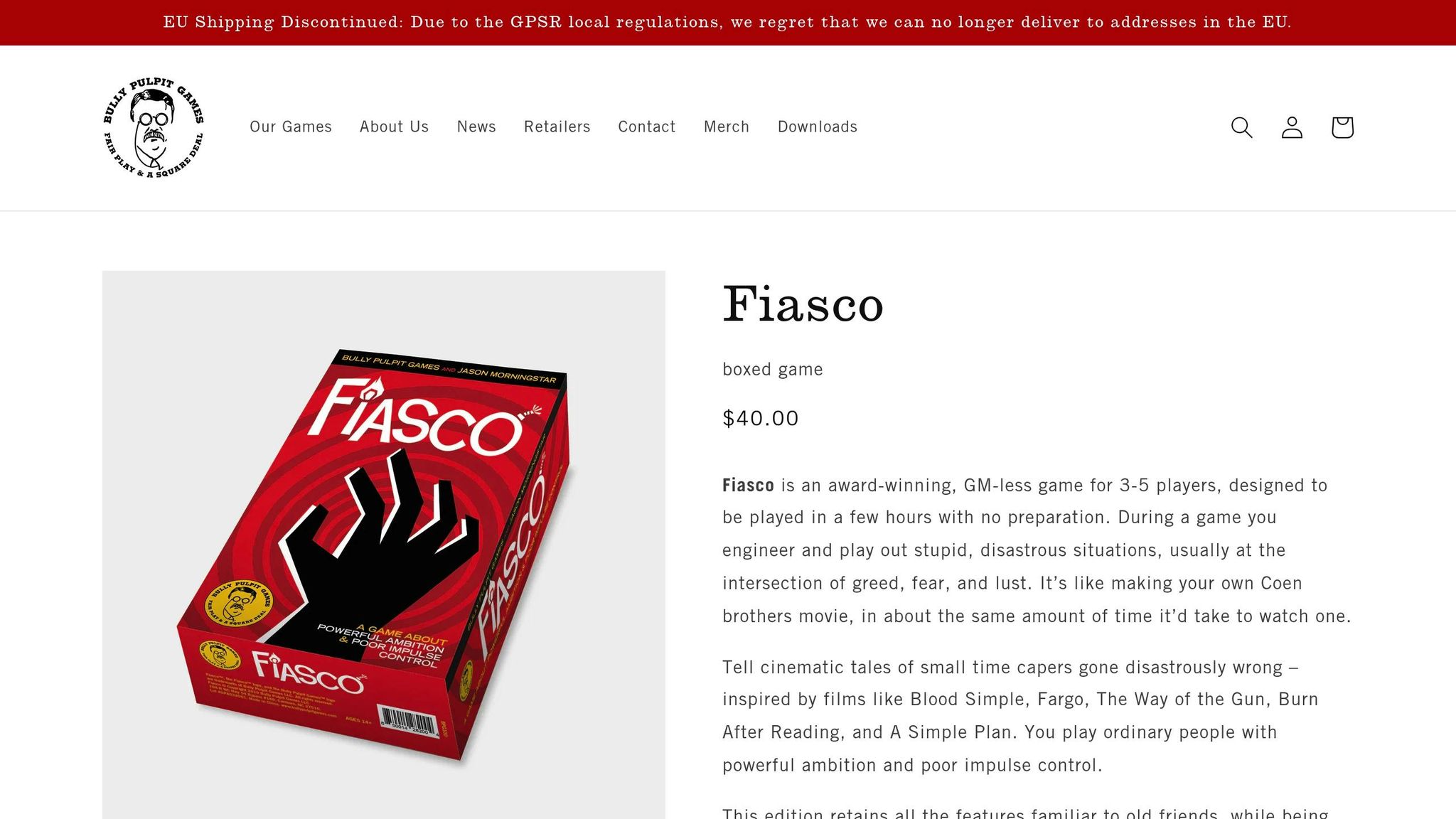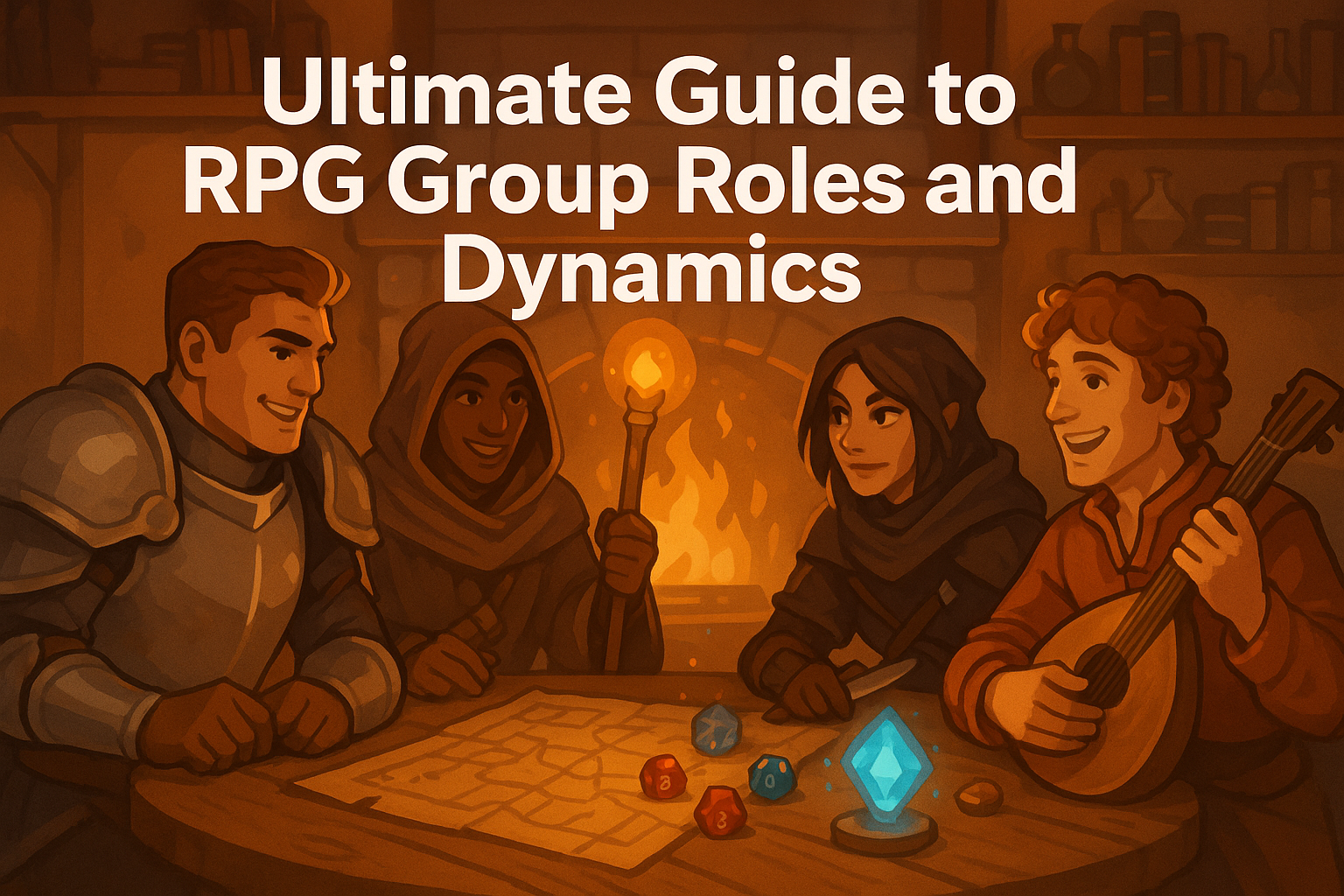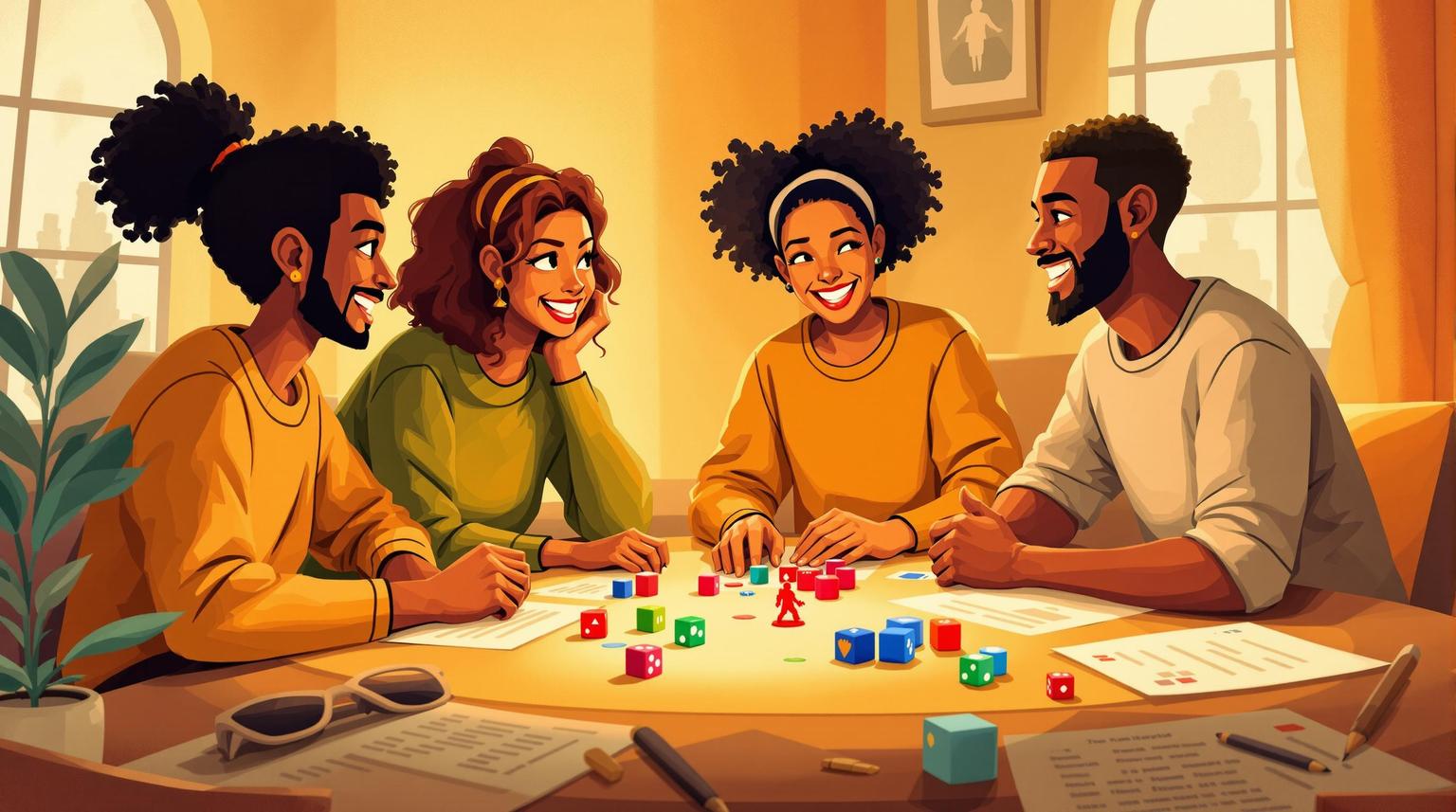Theater-of-the-mind play focuses on storytelling without maps or miniatures, relying on imagination to create shared experiences. Three tabletop RPG systems excel in this approach:
- Fate Core: Encourages collaborative storytelling with flexible mechanics like Aspects and zones. Players focus on narrative goals rather than rigid rules.
- Powered by the Apocalypse (PbtA): Uses a simple 2d6 system to drive story progression. It emphasizes player-driven world-building and fluid, descriptive gameplay.
- Fiasco: A GM-free game that prioritizes relationship-driven narratives. Players create dramatic, character-focused stories through structured scenes and twists.
Quick Comparison:
| System | Strengths | Weaknesses |
|---|---|---|
| Fate Core | Flexible mechanics, shared world-building | May feel unfamiliar to tactical players |
| PbtA | Simple dice system, collaborative stories | Limited tactical depth |
| Fiasco | No prep, dramatic narratives | Themes may not suit all groups |
Choose based on your group's preference for structure, improvisation, or storytelling depth.
How To Harness the Power of Theatre of the Mind
1. Fate Core

Fate Core is one of the most theater-of-the-mind–friendly tabletop RPG systems out there, designed specifically to put storytelling and creativity front and center. If your group loves diving into collaborative narratives without worrying about grids, miniatures, or rigid mechanics, this system is a perfect fit. It’s all about creating proactive, dynamic characters who live for drama and adventure.
At the heart of Fate Core is its Golden Rule:
"Decide what you’re trying to accomplish first, then consult the rules to help you do it."
This flips the traditional RPG approach on its head. Instead of letting the rules dictate what’s possible, players focus on their goals first. Then, they turn to the mechanics for support, making the game feel natural and intuitive.
Rather than relying on detailed maps or precise measurements, Fate Core uses conceptual zones to define spaces. A zone could be a bustling market, a precarious bridge, or the shadowy area behind an overturned wagon. These zones are shaped by the group’s imagination, adding flexibility and fluidity to the gameplay.
The system also introduces Aspects, a feature that fuels descriptive and dynamic play. Aspects are short phrases that highlight something unique about a character, object, or scene. For instance, a character might have the Aspect “Quick on My Feet,” which can be invoked by spending Fate Points to influence dice rolls or add flair to the narrative. This mechanic transforms ordinary moments - like a chase - into vivid, engaging scenes.
Fate Core’s Bronze Rule, also known as the Fate Fractal, takes the system’s flexibility even further:
"In Fate, you can treat anything in the game world like it's a character. Anything can have aspects, skills, stunts, stress tracks, and consequences if you need it to."
This means that anything - from a collapsing castle to a brewing political crisis - can become an active participant in the story, complete with its own mechanics.
Failure in Fate Core isn’t just a dead end. The system is designed to make setbacks part of the story. When a roll doesn’t go as planned, it often leads to a “success at a cost” scenario or opens the door to new, unexpected opportunities. This keeps the narrative moving and ensures that every twist feels meaningful.
World-building in Fate Core is a collaborative effort. The GM and players work together to create the setting, define relationships, and establish ongoing conflicts. This shared creativity enriches the game world and ensures everyone feels invested in the story.
Finally, the Silver Rule underscores the system’s commitment to storytelling:
"Never let the rules get in the way of what makes narrative sense."
With its focus on imagination, flexibility, and collaboration, Fate Core is a system that empowers players to craft compelling stories together.
2. Powered by the Apocalypse
Powered by the Apocalypse (PbtA) systems are built around the idea of storytelling and shared creativity, making them perfect for theater-of-the-mind gameplay. Instead of getting bogged down in tactical maps or complex rules, these games prioritize collaborative narratives and world-building. It’s all about creating an engaging story together, rather than focusing on exact positioning or intricate calculations.
At the core of PbtA games is a straightforward 2d6 mechanic. Here’s how it works: rolling a 10 or higher means a full success, 7–9 signals a partial success with some complications, and 6 or less is a failure. But even failures aren’t wasted - they often come with experience points, turning every roll into a chance to drive the story forward. This simple system keeps the focus on the narrative, allowing the game to flow seamlessly.
The Game Master (GM) plays a crucial role by setting scenes, steering the story, and encouraging players to contribute details like the environment or non-player characters. This approach fosters a group effort where everyone has a hand in shaping the game world. Even combat is handled in a fluid way, without rigid turn orders or the need for exact positioning. Instead, battles are resolved through vivid descriptions and by focusing on what the characters are trying to achieve, rather than relying on tactical grids. This style of play naturally leads to stronger character connections, a hallmark of PbtA systems.
One of the standout features of these games is the use of Bonds - narrative ties between characters that fuel interpersonal drama. Emily VanDerWerff from Vox captures this dynamic perfectly:
"In PBTA games, players roll two six-sided dice (or D6s) to determine whether they succeed or fail at tasks set for them by the game master. The GM, in turn, keeps things moving and tries to preserve a modicum of continuity. But the players also have extreme amounts of leeway to help shape the world and their relationships with other characters."
This collaborative style ensures that everyone at the table has a voice in the unfolding story. For GMs, success in running a PbtA game often comes down to painting vivid scenes that highlight each character’s unique traits. The focus is on evocative details and character-driven moments, not precise measurements or rigid setups. This makes every game session feel like a shared creative journey.
3. Fiasco

Fiasco takes a bold approach to storytelling by doing away with a Game Master entirely. This collaborative role-playing game is designed for 3–5 players and typically runs for 2–3 hours. Instead of focusing on stats, character abilities, or tactical maneuvers, Fiasco relies entirely on the players’ imaginations, creating a shared narrative experience without the need for physical components or detailed measurements. It’s a game that thrives on personal, emotionally charged stories.
One of Fiasco’s standout features is its relationship-driven character creation. Players use prompt cards - like "siblings", "backstabbed", or "hero and chump" - to establish connections between their characters. These relationships form the backbone of the story, prioritizing emotional depth and interaction over specific details. To add even more layers, players can draw additional cards for locations, objects, and character needs, setting up motivations and potential conflicts that fuel the drama.
The game’s structure is equally unique. Fiasco unfolds through a series of scenes, with players taking turns either Establishing (setting up the scene’s location, characters, and events) or Resolving (deciding how the scene plays out). This format encourages players to dive into rich, descriptive storytelling. As Clayton Ashley from Polygon explains:
"Fiasco's structure gives you the perfect framework to create your caper without the need for a narrator."
Playing Fiasco feels like directing a movie, where players describe scenes in cinematic detail - focusing on characters, settings, and even "camera angles" - rather than worrying about mechanics like movement speeds or attack ranges. Midway through the game, the "Tilt" mechanic introduces unexpected twists and complications, ramping up the tension. The game wraps up with an "Aftermath" phase, where players narrate the long-term consequences of their characters' actions, much like the closing scenes of a movie.
This inventive approach hasn’t gone unnoticed. Fiasco won the Diana Jones Award for Excellence in Gaming in 2011, earning praise from outlets like Wired, Eurogamer, and even Wil Wheaton, who said:
"Fiasco is unique among RPGs because it encourages us to actively reach for that moment we all dread in most games, that moment when something truly awful is going to happen, with possibly dire results for our characters."
sbb-itb-b8b00a5
Pros and Cons
To help you weigh your options, here's a breakdown of the strengths and weaknesses of each system:
| System Name | Pros | Cons |
|---|---|---|
| Fate Core | • Narrative flexibility: Works across any setting or genre, making it versatile • Character-driven focus: Aspects and Fate points encourage engaging, story-driven play • Collaborative creativity: Rewards imaginative contributions from players • Simple mechanics: Easy to learn with Fudge dice and straightforward modifiers |
• Adjustment period: Players accustomed to tactical systems may need time to adapt |
| Powered by the Apocalypse | • Streamlined gameplay: Uses a simple 2d6 system with clear outcomes • Collaborative world-building: Players have a hand in shaping the story and relationships • Story progression: Even failures push the narrative forward • Conversation-driven: Focuses on dialogue instead of complex calculations |
• Less tactical depth: May not appeal to players who enjoy intricate combat mechanics • Limited customization: Offers fewer options for detailed character optimization |
| Fiasco | • No prep required: Great for quick, spontaneous sessions or conventions • GM-free design: Everyone shares the storytelling role • Emotionally charged stories: Focuses on personal, relationship-driven narratives |
• Mature themes: Content can be intense, violent, or dark, which may not suit all groups • Genre-specific: Works best for caper or dark comedy scenarios |
Each system offers something different, catering to a wide range of play styles and preferences.
Fate Core is ideal for creative groups who enjoy building worlds and weaving collaborative stories. Powered by the Apocalypse shines with its streamlined mechanics and emphasis on group storytelling. Meanwhile, Fiasco thrives in delivering intense, character-driven narratives, particularly for those comfortable exploring darker themes.
Ultimately, the best choice depends on your group's storytelling style and comfort level with the themes presented.
Conclusion
Theater-of-the-mind play thrives on collaborative storytelling and imaginative freedom, prioritizing narrative depth over tactical complexities. Systems like Fate Core, Powered by the Apocalypse, and Fiasco shine in this space, each offering a unique approach to creating immersive experiences. Here's how they stand out:
- Fate Core: With its aspect-driven mechanics and shared world-building, this system is perfect for groups that love weaving expansive, genre-spanning narratives. It encourages boundless creativity and collective storytelling.
- Powered by the Apocalypse: This system strikes a balance between structure and fluidity. Its straightforward 2d6 mechanics turn every roll into a narrative moment, empowering players to shape the story while maintaining a sense of direction.
- Fiasco: For those seeking a GM-less, improvisational experience, Fiasco thrives on the unpredictable outcomes of character decisions and relationship-driven drama. It’s storytelling at its most raw and collaborative.
"The reason I'm playing any particular tabletop RPG, instead of playing make-believe, is because I want the game to challenge and vex the fictional world I'm moving through. I want the game to cage me, to make it hard for me to do something I'm normally able to do, to create moments of inefficiency that sculpt how I behave. It's why we chose the game for the table!" – Jay Dragon, Game Designer
This quote perfectly captures why these systems are so effective: they introduce just enough mechanical tension to spark creativity while keeping the focus on immersion and storytelling.
Choosing the right system depends on what your group values most. Fate Core is ideal for those who love exploring long, character-driven arcs. Powered by the Apocalypse works well for streamlined, genre-specific adventures. And Fiasco is unmatched when it comes to embracing improvisation and chaos.
No matter which system you choose, the key to successful theater-of-the-mind play lies in clear communication, active listening, and a shared dedication to crafting the world together. These systems provide the tools to bring your group's stories to life in vivid, unforgettable ways.
FAQs
What makes Fate Core's collaborative storytelling unique compared to traditional RPG systems?
Fate Core shines for its collaborative storytelling approach, where both players and the Game Master (GM) share the reins of the narrative. One standout mechanic is the Compel system, which lets players introduce plot twists or obstacles for their characters in exchange for Fate Points. This keeps the story dynamic and ensures everyone stays engaged.
Unlike many traditional RPGs that lean heavily on strict rules and tactical gameplay, Fate Core thrives on flexibility and improvisation. The emphasis is on crafting a story together, with creativity and character-driven moments taking center stage, rather than focusing on intricate mechanics or detailed maps. It’s a fantastic choice for those who enjoy immersive, theater-of-the-mind experiences.
Why is Powered by the Apocalypse a great choice for narrative-focused and imaginative gameplay?
Powered by the Apocalypse: A Storytelling-Driven RPG
Powered by the Apocalypse is a fantastic system for players who love narrative-driven gameplay. It puts storytelling and creativity front and center, steering away from complicated rules. The mechanics are designed to be player-focused, encouraging improvisation, collaboration, and rich, descriptive play - perfect for those who prefer theater-of-the-mind experiences.
The rules are straightforward yet adaptable, allowing both players and GMs to dive into the story without getting tangled in technicalities. Its unique structure, built around moves and playbooks, keeps the game flowing seamlessly while offering plenty of space for imagination and personal touches.
When is Fiasco the best RPG system to use, given its unique GM-free setup?
Fiasco thrives in settings that emphasize collaborative storytelling mixed with chaos and unpredictability. It's tailor-made for spinning tales about flawed characters caught in high-stakes situations - think botched crime heists, disastrous plans, or darkly comedic dramas spiraling out of control.
What sets Fiasco apart is its GM-free approach, which encourages improvisation and creativity. This makes it a fantastic option for small groups looking for a fast-paced, story-driven experience without the need for a traditional game master. If you love crafting unpredictable, character-focused narratives packed with twists and turns, Fiasco is the perfect system to dive into.


